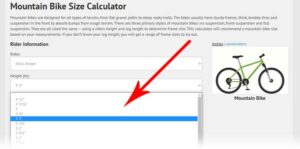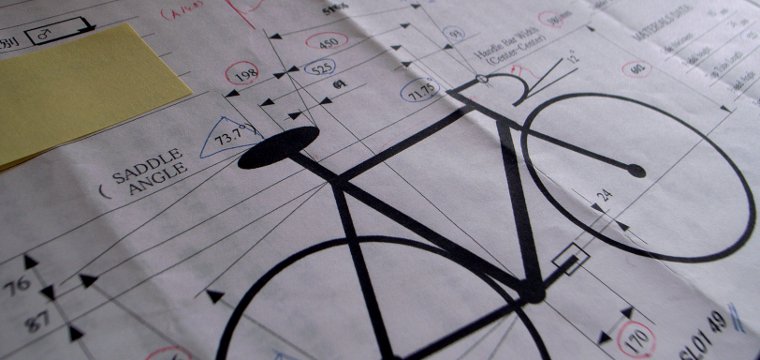Once you have determined the bicycle that bests suits, you’re ready to shop.
However before you hand over your cash or credit card, you should do a fit to ensure the bicycle that best suits your riding style and needs is also the right physical size.
Fitting the bike will go a long way towards how comfortable and successful it will be. It’s also particularly important for children, as buying a bike they can “grow into” can actually be dangerous if it’s oversize. You can navigate this article using the links below:
- Bicycle Size Calculator
- Bicycle Sizing Chart
- Frame Size
- Seat Position
- Handlebars
- Wheels
- Pedals / Cranks
Fitting the Bicycle
To avoid feeling cramped or awkward and make the most of your pedaling action you should ensure the bike frame, seat and handlebars are sized correctly for you.
Bicycle Size Calculator
Some websites provide tools that will calculate your bicycle frame size. These usually provide good starting point when shopping for a bicycle. They take your height and bicycling inseam, and return a recommended frame size.

Free online tool that calculates your bicycle frame size using your your height and leg length. | Image © eBicycles.com
Here is the eBicycles tool for calculating what frame size you need. You’ll get a personalized bicycle size sheet that you can print and take with you when looking at bikes.
Bicycle Sizing Chart

Helpful frame sizing chart to figure out what frame size you need. | Image © eBicycles.com
Sizing charts using your height and bicycling inseam (the distance from the ground to your crotch) can also give you a basic idea of the frame size you need for your bike. These sizing charts are available online or you could ask at your local bicycle shop.
The bike measurements are given for the frame of the bike, which, for road and mountain bikes, is the distance from the top of the seat tube (rather than the seat) to the center of the bottom bracket.
For a mountain bike you normally require a frame 10-12 centimeters smaller than a road bike. Remember the chart is a guideline only and the final size you choose may vary.
You can download frame size charts from eBicycles also.
Frame Size

Racing bicycle with traditional style frame. The frame is the main part of a bicycle. | Image © BruceTurner / CC by 2.0
The frame size of the bike must be right for you, otherwise cycling can become hard work and uncomfortable.
If you’re too cramped you won’t be able to extend your leg into a full cycle to maximize power. Alternatively if the frame is too big you will get not get a full drive from your leg rotation either.
A quick way to check the frame size is to stand over the frame with both feet on the ground. If you have an inch or so between the frame of a racing, touring or hybrid bike and your crotch it should be about right.
For a mountain bike the distance to the frame should be greater. For children the best way to ensure the frame is the correct size is to have the child sit on the seat and be able to place the balls of their feet on the ground and reach the handlebars comfortably.
You should also ensure they have a 25-50mm clearance between the bar and their crotch if they are standing over the center bar.
Seat Position
Some riders prefer a seat that is tilted slightly forward or backward but most prefer one that is pretty much level so you don’t feel you’re sliding forward or slipping off the back.
It may take some trial and error to see what works best for you. But basically the seat should be positioned so your feet will rest naturally above the pedals and when you extend your leg through the cycle it is almost completely straight at the bottom.
You should not have to move your hips from side to side to reach the pedals.
Handlebars
The position of the handlebars is more important than many beginner riders realize. The wrong angle can lead to back pain, shoulder strain or soreness in your wrists. Generally handlebars are sized to the bike and come in different widths.
On racers and touring bikes they are usually the same width as your shoulders, whereas on mountain bikes they are wider.

Drop handlebars on a road bike have a height and tilt adjustment. | Image © Ethan Lofton / CC by 2.0
Handlebars can also be placed at different heights. On road bikes handlebars are about an inch lower than the top of the saddle, whereas on a mountain bike they are even lower to provide a lower center of gravity, while on hybrids they are usually higher for a more upright position. If you prefer a more upright position so you can really look around and don’t feel so stretched out, then set your handlebars higher.
This position does mean you are a little less aerodynamic but if you have drop bars you can still get down low on windy days. If you prefer to be riding in a forward position then you should set your handlebars at the same height as the seat.
Whatever you do, take note of the minimum insertion mark and don’t fix the handlebars higher than this or the stem will not grip in the frame properly.
Wheels
The wheel size is the measurement of the diameter of the wheel with a mounted tire. Usually the size is written on the tire sidewall, for example it might read 26 x 2.2”, a typical mountain bike size.
This indicates the wheel is 26” and the tire is 2.2” wide. Wheels are categorized in size by their primary use for road cycling, off road, touring and BMX. For example wheels used for stunts and jumps in BMX will be smaller to take the additional loads placed on them.

Mountain bike wheels are smaller, wider and sturdier than those on road bikes. They are commonly sized at 26″ or 29″. | Image © Larry Woo / CC by 2.0
Mountain bikes are generally 26” (559mm) or 29” (622mm) in size and usually recorded in inches because they originated in the USA. The larger size is often used in cyclocross and for larger mountain bike riders.
Cruisers and leisure bikes are often the same size. Road bikes, touring bikes and most hybrids are likely to have 700c (metric) wheels also known as 29”, which are a lot slimmer (usually 18-25 mm in width).
The larger diameter rim rolls more easily than smaller ones although some triathletes and multi sport athletes now use 650c wheels which have less rotating mass. Older road bikes might have 27″ wheels. BMX bikes are usually in two sizes; either 500 mm (20”) or 600 mm (24”).

Road bike wheels are thin and light weight. They are commonly sized at 29″ or 700c. | Stock photo © Fatkid32 / CC BY-NC-ND 2.0
The size of wheels for children’s bikes is different and will vary depending on the age of the child. Usually small trainer wheels are used for younger children and can be raised higher as their confidence and skills increase.
Related: Best Electric Bikes
Children aged 3-5 years usually need 300mm (12”) wheels, while 5-7 year olds might require 400mm (16”) and 7-10 year olds 500mm (20“). Children over 10 years can usually fit bikes with 600mm (24”) or even 700mm (26”), which are sizes similar to adult bikes.
Pedals / Cranks

Pedals are connected to cranks, which turn the chain to provide power to the bicycle. Pedals come in standard, clipless and toe clip styles. | Stock photo © RapidEye
To ensure your riding motion is being transferred to the bike with maximal efficiency, you should consider clipless pedals or toe clips. This way you can clip your feet in and every pull or push motion you make will propel the bike forward better.
Generally the cage like toe clips are considered more cumbersome than clipless pedals, but they do allow you to use your normal shoes and save you having to purchase cycling shoes. Clipless pedals come in different varieties for road and mountain biking.
The pedals used for mountain biking are dual sided, making it possible to clip in easily on rough and changeable terrain.
Feature Image Credit
- Bicycle Fit Datasheet © ryoichitanaka / CC BY 2.0


Leave a Reply